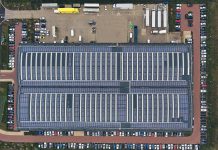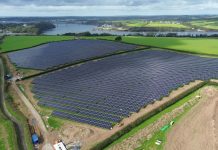 Scottish Power chief executive Keith Anderson has questioned the apparent obsession with achieving ‘subsidy-free’ renewables, warning it will not happen any time soon in the UK for technologies such as offshore wind.
Scottish Power chief executive Keith Anderson has questioned the apparent obsession with achieving ‘subsidy-free’ renewables, warning it will not happen any time soon in the UK for technologies such as offshore wind.
Anderson took part in a panel debate around ‘post-subsidy’ renewables at Aurora’s Spring Conference.
Asked which markets are most attractive to parent company Iberdrola in terms of ‘subsidy-free’ development, Anderson replied that he “hates the expression”.
“I can’t understand why the renewables industry has become obsessed with talking about becoming ‘subsidy-free’. Right now, nothing in the UK energy industry is being built without some form of support, so why in god’s name is the renewables industry running around desperate to [be seen] as subsidy-free?” Anderson asked.
“Everything has some form of support. If you think we are going build a £2.5bn offshore wind farm in UK at market risk, you’re bonkers.”
While power purchase agreements (PPAs) with large corporates are seen as a way of mitigating risk for developers, Anderson said the UK market for such deals is nowhere near mature.
“If the only thing out there is a corporate PPA, the market will slow down dramatically, because frankly, that market doesn’t really exist in UK [at the scale required],” he said. “That might change in 5-10 years, but it doesn’t exist right now.”
Anderson lauded the contracts for difference (CfD) support mechanism, which stabilises revenues for renewables and low carbon generators, as more successful than its predecessor, the Renewables Obligation.
“It has been fantastic at bringing real competition into auctions and driving down prices.”
The most recent CfD auction saw some offshore wind projects take a strike price of £57.5/MWh, around half the price of early offshore wind contracts. Anderson suggested prices would fall further due to supply chain investments, but reiterated his call for continued support.
“I caution against talking about subsidy-free world, or a world without a mechanism to underpin investment risk,” he said, pointing to the ongoing construction hiatus of unsubsidised large power stations.
“A gas plant is probably the easiest and quickest thing to build… but nobody is building those right now.”
Asked whether the Capacity Mechanism was viewed as a subsidy, Anderson replied that it was “meant to underpin investment risk”, but for large thermal plant such as combined cycle gas turbines, or CCGTs, “it is just not doing it”.
“So if you want that type of investment [CCGTs], you need to underpin that investment risk.”
Anderson added to calls from other renewables companies speaking at the conference to bring onshore wind into the CfD mechanism.
“If it is the cheapest form of generation, then underpin it with a market mechanism,” he said. “Why shouldn’t UK consumers get the benefit of that cheap energy?”
Click here to see if you qualify for a free subscription to the print magazine, or to renew.
Follow us at @EnergystMedia. For regular bulletins, sign up for the free newsletter.




9,999 in 10,000 of the general public [including many energy aficionados] are totally unaware that electricity from ‘green energy’ [wind and solar pv] is insanely expensive compared to electricity from nuclear power.
And the tragedy of it all is – it can so easily be demonstrated by simple arithmetic an 11 year-old can do:
But first of all, the duplicity of wind farm and solar park operators [in the UK] has to taken into account, because initial claims of ‘Homes Powered’ are not followed up by mention of the deterioration in output of these technologies with each year of operation.
The 950 MW, £1,800 million Moray East Offshore Windfarm [MEOW], on its website, states it is: “…capable of providing power for the average needs of over 950, 000 UK homes. (assuming 3,300kwhr p.a)…”, which gives a capacity factor [cf] of 37.67%. But wind turbine performance degrades by 1.6% p.a., so in the final year of its 25 year lifespan it will be powering 645,069 UK homes. The average cf over the 25 years works out at 31.25%.
The 3,200 MW, £18,000 million Hinkley Point C [HPC] nuclear power plant will have an average 90% cf over its 60 year design life.
Here are the sums:
90% cf ÷ 31.25% cf = 2.88
60 year design life ÷ 25 year lifespan = 2.4
2.88 x 2.4 = 6.912
6.912 x 3,200 MW = 22,118 MW
It takes 22,118 MW of the very latest 9.5 MW wind turbines to sputter out the same amount of intermittent, grid-degrading electricity as the 24/7, grid-friendly electricity generated by HPC.
At £1,800 million for 950 MW:
Cost of 22,118 MW = (22,118 MW ÷ 950 MW) x £1,800 million = £41,908 million.
Capital cost of HPC: £18,000 million.
Capital cost of 22,118 MW of offshore wind [23.28 MEOWs]: £41,908 million.
IT GETS WORSE:
Adding together the ‘Significant Costs’ – capital; O & M; fuel; decommissioning:
HPC’s tots up to £34 billion.
22,118 MW of offshore wind tots up to £76 billion.
A perceptive question from any true environmentalist might be:
How do all of these extra costs for offshore wind accrue? And the answer is:
A vast amount of wasted resources – 20X more metals and 10X more concrete than nuclear to deliver the same amount of electricity.
A vast amount of wasted energy – in mining, processing and transporting materials [not forgetting all that extra environmental, ecosystem and species destruction].
A vast amount of wasted labour – the ‘green-jobs’ delusion.
But the cheapest form of electricity remains, as ever, the electricity you don’t need to use. And, Keith Anderson, please note, there are no subsidies for that.
Why the hell would we not want to indulge electricity if it is easy to create lots of it and cheap.
Simply because, dear Richard, every single form of electricity generation causes some environmental disbenefits. So it is always desirable to minimise its usage.
It’s surprising then that they are selling the power from Moray for £57.50 as opposed to £80 (tbd) for the proposed new power station or £92.50 for Hinkley.
Given the focus on energy storage on this site and the battery technology advances (re LTO, solid state), it seems foolish to burden future generations with nuclear waste management rather than follow the renewables/storage route.
Even with stable base load production like nuclear, we still have the day/night challenge, so storage is going to a big part of the solution whichever route is taken.
New Nuclear power, being intermittent (off 2 months every 2 years for refuel) and inherently inflexible when generating, already has the distributed energy developers salivating in anticipation.
Hinkley may not a be good deal for consumers but for investment banks and private equity the resultant energy market distortions present a field day of unavoidable opportunities.
Bring it on